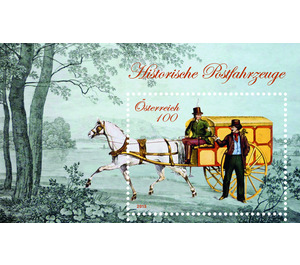Post vehicles Cariolwagen - Austria / II. Republic of Austria 2015
Theme: History & Politics
| Country | Austria / II. Republic of Austria |
| Issue Date | 2015 |
| Edition Issued | 170,000 |
| Item Type | Block |
| Chronological Chapter | OOS-OE2 |
| Chronological Issue Number | Block 88 |
| SID | 368251 |
| In 57 Wishlists | |
In 1830, the postal service within the capital and residence city of Vienna under the k. k. Colonel-Hofpostverwalter knight Maximilian Otto von Ottenfeld rearranged: With permission of the "high k. k. General Court Chamber "of 18 August 1830 dissolved the existing since 1772" Small Post "and built the Vienna city post. This was to facilitate the correspondence of the city dwellers among each other, the faster distribution of incoming letters and shipments in Vienna and senders who lived far away from the court post office, "a greater convenience in the abandonment of their correspondence and programs offer," as Adolf Bäuerle 1834 in In his book, "What Oesterreich owes to the rejoicing government of His Majesty the Emperor Franz the First?" For this purpose, the city of Vienna and its suburbs were divided into six main districts and these in turn into 46 "order districts", in the 73 "k. k. Letter collections "were included. Each main district received a Filialpostamt, the overall management took over the city post-Oberamt in the Viennese Wollzeile. The branch post offices, which were not all located within Vienna, and the city post-Oberamt were connected by the use of small horse-drawn carriages, so-called Cariolwagen. They were light and manoeuvrable because they had only two wheels and were pulled by a single horse - so they were only intended for distribution of the mail. The name derives from the French word "carriole" for "carts". Similarly light single-pronged cars had been used earlier in cities as well as in rural regions for the letter delivery - one spoke then also also of the "Karriolpost".


